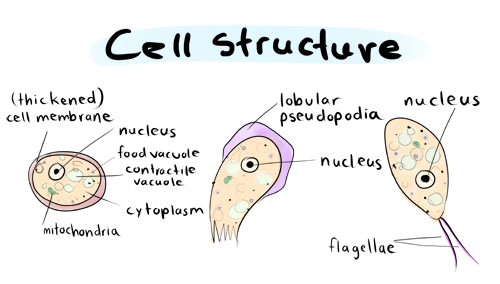- Naegleria fowleri exists as a free-living amoeba in freshwater such as lakes, and swimming pools and it cause dangerous amebic meningoencephalitis
N.fowleri has 3 forms:
- Amoeboid form (Trophozoite) —> seen in C.S.F and brain tissue
- Biflagellated form (Two flagella) —> seen in fresh water (lakes or swimming pool)
- Encysted form —> due to unfavorable conditions, lacks of food or cold temperatures
- N. fowleri invades the central nervous system via the nose (specifically through the olfactory mucosa and cribriform plate of the nasal tissues). It attaches itself to the olfactory nerve and migrates to the olfactory bulbs, where it feeds on the nerve tissue resulting in significant necrosis and hemorrhaging and causing meningitis and encephalitis
Signs and Symptoms:
- headache, fever, nausea, vomiting, and stiff neck. Secondary symptoms include confusion, hallucinations, lack of attention, ataxia, and seizures
Laboratory Detection:
- By looking at a fresh sample of CSF we can see the motile amebae under microscope, or we can do Giemsa-Wright staining
- other methods including doing culture, PCR, or Indirect fluorescent antibody

Naegleria fowleri trophozoite (arrow) stained with Giemsa-Wright amidst polymorphonuclear leukocytes and a few lymphocytes
References and Sources:
http://www.cdc.gov
http://workforce.calu.edu/
http://brainsenemy.wordpress.com




